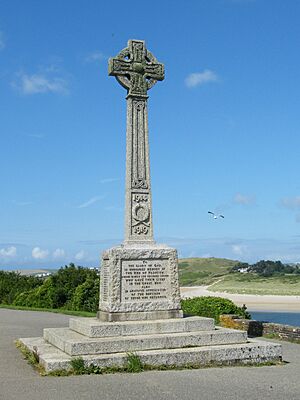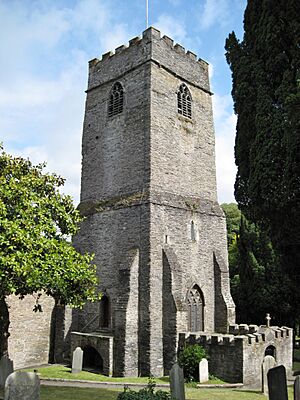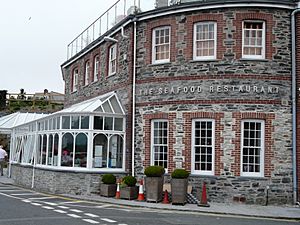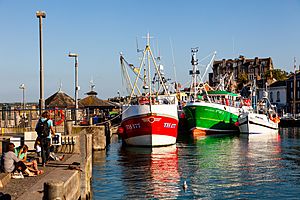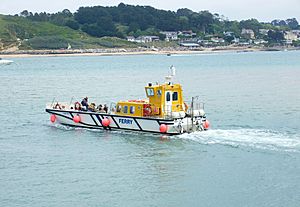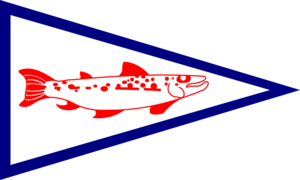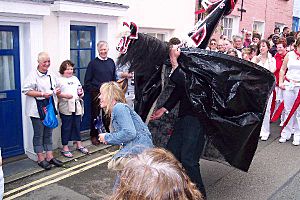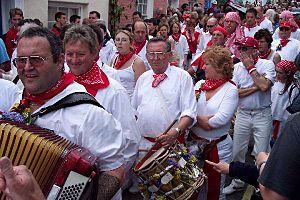Padstow facts for kids
Quick facts for kids Padstow
|
|
|---|---|
 Padstow Inner Harbour & quayside |
|
| Lua error in Module:Location_map at line 530: Unable to find the specified location map definition: "Module:Location map/data/Cornwall (mainland)" does not exist. | |
| Population | 2,993 (Civil parish, 2011) |
| OS grid reference | SW918751 |
| Civil parish |
|
| Unitary authority | |
| Ceremonial county | |
| Region | |
| Country | England |
| Sovereign state | United Kingdom |
| Post town | PADSTOW |
| Postcode district | PL28 |
| Dialling code | 01841 |
| Police | Devon and Cornwall |
| Fire | Cornwall |
| Ambulance | South Western |
| EU Parliament | South West England |
| UK Parliament |
|
Padstow (pronounced PAD-stoh) is a town and fishing port located on the north coast of Cornwall, England. It sits on the west side of the River Camel estuary. The town is about 5 miles (8 km) northwest of Wadebridge and 10 miles (16 km) northeast of Newquay. In 2011, about 2,993 people lived in Padstow.
The area around Padstow has interesting rock formations. For example, Tregudda Gorge has very steep cliffs. Marble Cliffs show layers of dark and light grey rock. The Round Hole is a sea cave that has collapsed, creating a large hole.
Contents
History of Padstow
Padstow's original English name was Adelstow. This name came from Æthelstan, an old English king. Later, the town was called Petroc-stow, meaning 'Petrock's Place'. This was named after Saint Petroc, a Welsh missionary. He arrived in the area around the year 500 AD.
After Saint Petroc died, a monastery was built here. It was very important until Vikings raided the area in 981. After the attack, the monks moved inland to Bodmin. They took Saint Petroc's special items with them.
In the year 1086, Padstow was mentioned in the Domesday Book. This was a big survey of England. It showed that Padstow belonged to Bodmin Monastery.
During the Middle Ages, Padstow was also known as Aldestowe (meaning 'old place'). It was also called Hailemouth, which means 'estuary mouth' in Cornish. The modern Cornish name for Padstow is Lannwedhenek.
Padstow was very important in the Middle Ages. It was a safe harbour, which was rare on the north coast. This helped it become a busy fishing port. The town also had nine chapels, besides the main church.
Padstow grew rich by trading with Ireland and other ports. It exported things like tin, copper, and fish. It imported timber from Norway and wine from France. In the 1800s, many people left Padstow to move to Canada.
Shipbuilding also became important in Padstow. There were five shipyards at one point. However, this industry slowed down by 1900. When the North Cornwall Railway reached Padstow in 1899, tourism started to grow. The fishing industry also saw a boost.
The old seal of Padstow showed a ship with three masts. It had the words "Padstow" on it.
The TV show Time Team visited Padstow in 2008. They filmed an episode about the town's history.
There are also some old Cornish crosses in the area. One is in a wall at the old vicarage. Another is at Prideaux Place.
During World War II, in 1940, a bomb hit Padstow. It destroyed some houses and sadly killed three people.
Churches in Padstow
The church of St Petroc in Padstow is one of four churches said to have been started by the saint. It is a large church, mostly built in the 1200s and 1300s. Inside, there is a beautiful font from the 1400s made of Catacleuse stone. The pulpit, built around 1530, is also very interesting.
Economy and Tourism
Padstow was traditionally a fishing port. Today, it is a very popular place for tourists to visit. Some fishing boats still use the harbour. However, it is now mainly a place for yachts. The coastline here is dramatic, but there are not many safe harbours.
The famous chef Rick Stein has had a big impact on Padstow. Many tourists come from far away to eat at his restaurants and cafes. Some people even call the town "Padstein" because of his influence!
A new skatepark was built in Padstow. It opened in 2019 at the Recreation Ground.
Getting Around Padstow
Sea Travel
Padstow was very important for sea travel in the Middle Ages. It was a safe harbour, which helped it become a busy fishing port. Padstow traded with Ireland and other ports in England and Wales. It exported tin, copper, and fish. It imported timber, salt, and wine.
In the 1800s, Padstow was a major port for people leaving England. Many people sailed from here to Canada. Ships from Canada would bring timber to Padstow. These ships also offered cheap travel for people wanting to move to Canada.
Shipbuilding was a long tradition in Padstow. The town even built ships for the siege of Calais in 1346. By the late 1800s, there were five shipyards. But this industry declined by 1900.
The entrance to the River Camel from the sea has a big sandbank called the Doom Bar. This sandbank is dangerous for ships and has caused many shipwrecks. A lifeboat station was set up in 1827 to help ships in trouble.
Cliffs near the entrance could block the wind, making it hard for ships to steer. This often pushed them onto the Doom Bar. A special capstan (a winding machine) was built on the riverbank. Rockets were used to send a rope to ships, so they could be pulled to safety.
Ferries have crossed the Camel estuary for hundreds of years. Today, the Black Tor Ferry carries people between Padstow and Rock every day.
In 1964, the harbour was improved. It has an outer harbour for larger ships and an inner harbour for yachts. The inner harbour has a special gate that keeps the water level high. This means yachts stay floating even when the tide goes out.
Train Travel
From 1899 to 1967, Padstow railway station was the end of the line for the old Southern Railway. This railway line was part of the London & South Western Railway. It brought many holidaymakers to Padstow.
A famous train called the Atlantic Coast Express used to run directly from London Waterloo to Padstow. However, the station closed in 1967. The old railway line is now the Camel Trail. This is a popular path for walking and cycling. It follows the beautiful River Camel.
Today, the closest train station is Bodmin Parkway. Buses can take you from Padstow to this station.
Bus Services
Padstow has bus services that connect it to other towns. Bus service 56 goes to Newquay. Bus service 11/11A goes to Plymouth and also stops at Bodmin Parkway train station. These buses run often during the week. There is also the Atlantic Coaster, an open-top bus service from Newquay.
Walking and Cycling Paths
The South West Coast Path runs along both sides of the River Camel estuary. You can cross from Padstow to Rock using the Black Tor ferry to continue on the path. This path offers great walks along the coast. You can easily walk to places like Stepper Point and Trevose Head.
The Saints' Way is a long-distance walking path. It starts in Padstow and goes all the way to Fowey on the south coast of Cornwall.
The Camel Trail is a popular path for cycling, walking, and horse riding. It follows the route of the old railway line from Padstow. The trail is about 17 miles (27.7 km) long. It leads to Wadebridge, Wenford Bridge, and Bodmin. Many people use this trail each year.
Culture and Festivals
'Obby 'Oss Festival
Padstow is famous for its "'Obby 'Oss" festival. This event happens every year on May Day. Its exact beginnings are not clear, but it might come from an old fertility rite or the Celtic festival of Beltane.
The festival starts at midnight on May Eve. People gather to sing the "Night Song." By morning, the town is decorated with greenery and flowers. The main event begins when the 'Obby 'Osses appear. These are male dancers dressed as two special horses, the "Old" and the "Blue Ribbon" 'Obby 'Osses. They wear masks and large black capes. They try to playfully "catch" young women as they dance through the town.
Throughout the day, two parades move through the streets. Each parade is led by the "Mayer" and followed by a band playing accordions and drums. Then comes the 'Oss and its "Teaser" (a helper). Many people follow along, singing the "Morning Song."
Late in the evening, the two 'osses meet at the maypole. Then they return to their "stables." The crowd sings about the 'Obby 'Oss's "death," until it is "reborn" the next May Eve.
Mummers' Day
On Boxing Day and New Year's Day, some people in Padstow take part in a tradition called Mummers' Day. This is an old midwinter celebration. People disguise themselves and parade through the town singing songs.
This tradition is part of Cornwall's ancient pagan heritage. In the past, people all over Cornwall would take part in guise dancing. They would disguise themselves by painting their faces or wearing masks. The day has now been renamed Mummers' Day to connect it more clearly with these old Cornish traditions.
Other similar traditions in the United Kingdom include the Border Morris dancers and Molly dancers.
Cornish Wrestling
Cornish wrestling tournaments have been held in Padstow for at least 200 years. These wrestling events have taken place at different locations in the town, like the Drill Hall and the "Lawn" overlooking the harbour.
Notable People from Padstow
- Paul Ainsworth: A chef with a Michelin star who runs several businesses in Padstow.
- Dr. Humphrey Prideaux: Born in Padstow in 1648, he became the Dean of Norwich.
- Donald Rawe: A Cornish writer and poet, born in Padstow. He was known by his bardic name Scryfer Lanwednoc ('Writer of Padstow').
- Rick Stein: A famous chef and restaurateur who owns many restaurants and businesses in the town.
- Enys Tregarthen: An author and expert on folklore.
See also
 In Spanish: Padstow para niños
In Spanish: Padstow para niños


